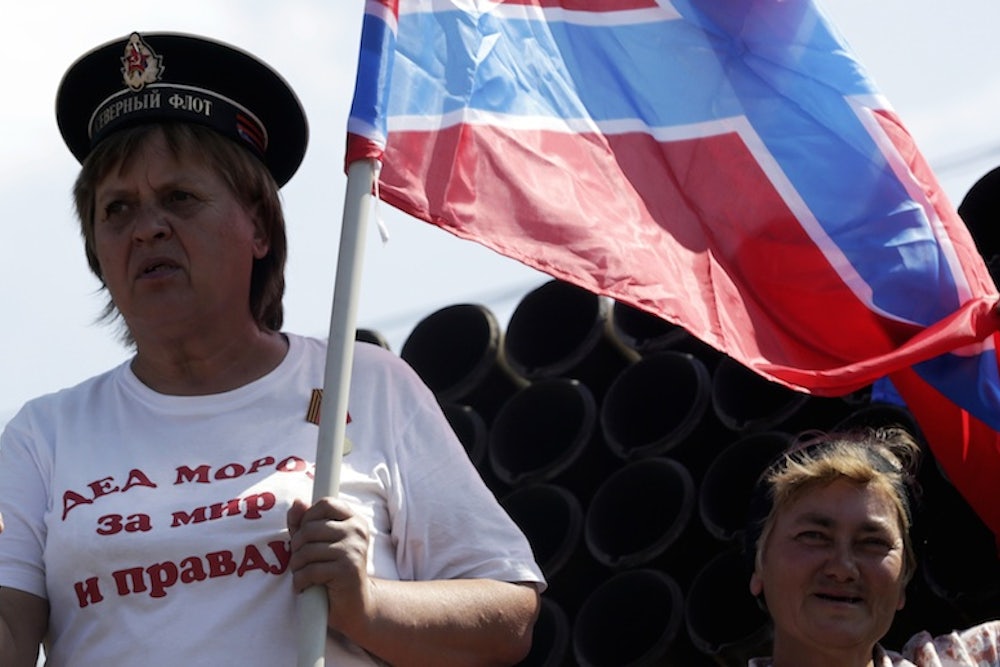There are a lot of ways to ensure there will be no diplomatic solution to a crisis. Launching a renewed ground invasion one day prior to scheduled peace talks, as Russia seems to be doing in Ukraine, is one of them.
On Monday, Ukraine’s National Security and Defense Council reported that a new front has opened up in the fight against Russian separatists in southeastern Ukraine, where at least ten Russian tanks, some bearing the insignia of the rebel Orthodox Liberation Army, crossed into Ukrainian territory and started heading for the coastal city of Mariupol. “The invasion of the Russian occupiers is taking place," Semen Semenchenko, a Ukrainian commander in the region, told Reuters.
It does seem that way, especially given Russian Foreign Minister Sergey Lavrov’s announcement Monday morning that Russia plans to send a second humanitarian convoy into Ukraine, by the same route as the first, “in the coming days."
Nevermind that sending in the first convoy was taken, NATO Secretary General Anders Fogh Rasmussen said, as “a blatant breach of Russia's international commitments,” specifically those that Lavrov himself agreed to last week in Berlin, which stipulated that the humanitarian aid the trucks are carrying would be fully inspected and turned over to the Red Cross.
The unilateral decision to send the humanitarian convoy into Ukraine was the first step in Russia’s apparent effort to shift the narrative in eastern Ukraine in its favor just ahead of scheduled talks between Russian, Ukrainian, and European leaders in Minsk next week. Ukrainian forces let the convoy pass through Ukraine without obstacle, after both sides traded accusations as to who would be responsible for the convoy should it come under fire. “[I]f any harm comes to the trucks, the risk is that the conflict could shift from Ukrainian soldiers fighting pro-Russian rebels to it fighting actual Russian troops out in the open,” Jason Karaian writes for Quartz. The provocation may not have worked the first time, so why not try again?
The second step was making every attempt to undermine celebrations of Ukrainian Independence Day throughout the country on Sunday. Kiev marked the occasion with a bombastic, Soviet-style military parade through Independence Square. Ukrainian President Petro Poroshenko, who led the parade, said in an Independence Day address that Ukraine would commit $3 billion to support its armed forces, and “compared recent events to those of the 1930s, when Nazi Germany stirred up ethnic Germans living in neighboring countries to create a pretext for invasion,” Andrew Higgins reports for The New York Times. In response, Russian State Duma Speaker Sergei Naryshkin concluded that the military parade “was set up to demonstrate aggressive plans to escalate the crisis.”
The more disturbing evocation of World War II came from Donetsk, where about 50 Ukrainian soldiers taken captive by rebel forces were paraded through the city alongside charred Ukrainian military vehicles, “like their German inspirers were in Moscow,” said Aleksandr Zakharchenko, prime minister of the self-declared Donetsk People’s Republic (DNR). A street cleaning machine followed behind them, “a clear reference to the march of captive German soldiers in Moscow in 1944, where a street cleaner symbolically washed the road after them,” Helen Mukhina reports.
Separatists holding bayonets marched alongside the prisoners, while the hundreds of people in the assembled crowd waved the flags of the DNR and Novorossiya, throwing flour and eggs at the captive soldiers marching by. As Human Rights Watch points out, it’s a war crime to humiliate or degrade prisoners of war, a violation of Article Three of The Geneva Conventions.
But Russia has its own interpretation of war crimes. In a press conference on Monday, Lavrov said that he had watched the video of the parade and saw nothing humiliating in it, adding that the real war crimes in Ukraine have been committed by “Ukranian batallions not reporting to anyone but oligarchs” and the National Guard “partly formed of the Right Sector,” according to RT’s footage of his remarks.
The concerted escalation of the past few weeks is further evidence of the dissonance between opposing sides of the conflict. While in American and European news sources it has seemed as if Ukrainian forces were almost ready to claim victory, “That's not the Russian perspective. They’re of the opinion that [the separatists] are holding their own, continuing to get volunteers and equipment from the Russian side,” says military analyst Raymond Finch. A recent shakeup of rebel leaders, which replaced Russian nationals with Ukrainians, may be aimed at legitimizing the separatist republics in the eyes of locals, many of whom have grown increasingly resentful of the human toll of the Ukrainian government’s relentless “anti-terrorist operation” to win back territory in rebel strongholds.
Russia is unquestionably “more interested in resupplying separatists rather than supporting local populations,” as NATO General Philip Breedlove said, and that means any cessation in fighting, especially by diplomatic means, at this point amounts to little more than a pipe dream. Novorossiya may be coming apart at the seams, but that doesn’t mean the Kremlin will give up on stitching some part of it back together.
